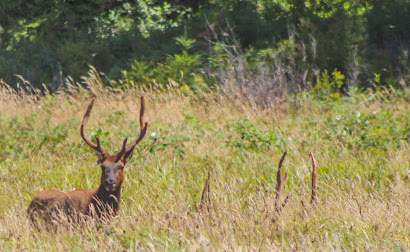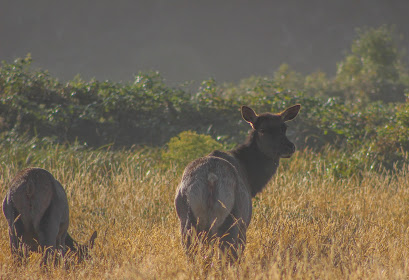The Roosevelt elk, also known as the Olympic elk, is the largest of the four subspecies of elk in North America. I've seen them once before, in Olympic National Park in Washington.
iNaturalist currently has 1,280 sightings of Roosevelt elk from as far north as the northern end of Vancouver Island in British Columbia to as far south as Westport, California, which is 186 miles north of San Francisco.
On our recent trip to northern California we saw quite a few Roosevelt elk in different locations. Our first view was along the Newton B. Drury - Redwood Scenic Parkway, north of Orick, in Elk Meadow. At least four bull elk were laying down in long grass. As we watched, they would completely disappear, then some antlers would show, then a head, and so forth.
 |
| Just the head and antlers of this elk are visible. |
 |
| Two elk are partially visible. |
 |
| Four elk partially visible. |
Our next sighting was just outside of Crescent City, in a field opposite where the Endert's Beach road turns off from Hwy 101.
A little later, I saw elk in a different spot just a half mile or so away, along the top end of Endert's Beach Road. First I saw a cow right next to the road (and right next to an elk sign), then I noticed a bull and some other cow elk further back off the road (I did not get any good photos of the other cow elk). The light was bad so the photos aren't very good.
 |
| Velvet is shedding off the antlers. |
The next morning we saw more elk in a different part of the large field off Hwy 101 and opposite the road to Endert's Beach. The elk were much closer and the early morning sun also made photos difficult.
Finally, just east of Big Lagoon in Humboldt Lagoon State Park, north of Eureka, while driving along Hwy 101, I saw elk in a field at some distance. I got a few long photos of the elk.
One of the amazing things about several of these elk sightings was that they were very close to human dwellings. At least where we visited, there did not seem to be huge areas of uninhabited land for the elk to roam in. It is impressive that the elk have been able to survive as human habitation has converged on their space.















I'm a little surprised to see so many males hanging out together without a huge group of females. Are they not territorial about their herd?
ReplyDelete